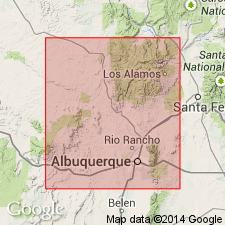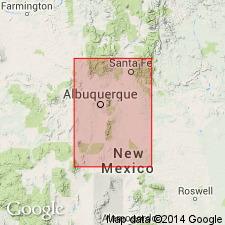
- Usage in publication:
-
- Sandia Granite
- Modifications:
-
- First used
- Dominant lithology:
-
- Granite
- AAPG geologic province:
-
- Southern Rocky Mountain region
Summary:
First published use as a name applied to a distinctive porphyritic biotite granite pluton in the Sandia Mountains. Extends for 20 miles along Sandia Mountain front from tip of Four Hills in T9N (Bernalillo Co, Southwestern Basin-and-Range region) north to Placitas (Sandoval Co, Southern Rocky Mountain region). Geologic map. Bounded on west by alluvium, or locally by downfaulted Santa Fe [Group], on east by Cibola Gneiss (first used), and along crest of range by Pennsylvanian rocks. Generally trends northeastward between Rincon Ridge Metamorphics (first used) and Tijeras [Greenstone] (new). Is homogeneous. Consists of microcline phenocrysts--some as much as 3 inches across--in a granitoid groundmass of quartz, feldspar, mica. Weathered outcrops have a nubby surface due to disintegration of its granular groundmass. Ranges from gray to brown. Has magmatic inclusions that range from tiny blebs to bodies several ft in length with no systematic arrangement; they may be melanocratic granitoid (the most abundant), leucocratic granitoid, gneissic, or quartzitic. Has small orbicular masses. Is the youngest Precambrian rock in the area. Has isotopic ages of 1,340 and 1,350 m.y. (K-Ar, Rb-Sr). Crystallization age of 1,500 +/-10 suggested on U, Th-Pb, Pb-Pb, K-Ar, Rb-Sr, and fission track.
Source: GNU records (USGS DDS-6; Denver GNULEX).

- Usage in publication:
-
- Sandia Granite
- Modifications:
-
- Overview
- AAPG geologic province:
-
- Southern Rocky Mountain region
Summary:
Is a quartz monzonite to granodiorite exposed in the west escarpment of the Sandia Mountains, west of Albuquerque, Bernalillo Co., NM in the Southern Rocky Mountain region. Very weathered. Best exposures found in Tijeras Canyon. In contact with "Juan Tabo series" in northern exposures. Thought to consist of two plutons -the North Sandia pluton and the South Sandia pluton; both are homogeneous and fine grained. Rb/Sr isochron age of 1.47 +/-0.02 Ga and a Pb/Pb average age of 1.44 +/-0.04 Ga have been reported by different workers. Considered equivalent to Fenton Hill granodiorite (first use? as an informal? name) on basis of similar mineralogy, chemistry, and geochronology (tables). Adjacent [?] "Cibola gneiss" has a 1.58 +/-0.07 Ga Rb/Sr age. The high sphere content (1-1.5 percent) in the Sandia and Fenton Hill distinguishes them from other plutons in central and south-central NM.
Source: GNU records (USGS DDS-6; Denver GNULEX).
For more information, please contact Nancy Stamm, Geologic Names Committee Secretary.
Asterisk (*) indicates published by U.S. Geological Survey authors.
"No current usage" (†) implies that a name has been abandoned or has fallen into disuse. Former usage and, if known, replacement name given in parentheses ( ).
Slash (/) indicates name conflicts with nomenclatural guidelines (CSN, 1933; ACSN, 1961, 1970; NACSN, 1983, 2005, 2021). May be explained within brackets ([ ]).

